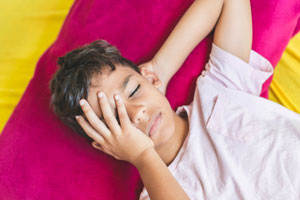Heads up: Managing your child’s pain
APRN, CNP, DNP
Neurology
CentraCare Neurosciences
Occasionally, your third grader will have a headache after school. You give her a snack, she rests for a while and feels better. Today, you receive a call from her school telling you that she has a headache and is vomiting. Your mind races as you wonder what is causing her headaches.
Headaches are common. According to the National Survey of Children with Special Health Care Needs, about 10 percent of children up to 17 years of age live with migraine or frequent headaches. During elementary school, more boys than girls have headaches, but during adolescence, more girls than boys have them. If your child gets headaches but feels totally normal between the headaches, you should feel reassured.
Types and triggers
A common type of headache in children is a regular or tension headache, which is usually not as disabling as a migraine. Children can still attend school or participate in sports but may act “under the weather.” Stressors that affect kids include changes in their sleep schedule and daily routine, dehydration and school-related issues such as learning struggles, social conflict or bullying. Tension headaches respond to oral fluids, snacks and ibuprofen or acetaminophen.
Migraines are other headaches seen in children. Kids with migraines are often related to someone with migraines. A migraine is considered to be a “primary” headache, meaning that there is no other cause for it such as a viral or bacterial infection, concussion or other disorder. A child with a migraine has throbbing pain across the forehead, temple areas or the entire head, nausea and/or vomiting and light and/or sound sensitivity. The headache also worsens with normal physical activity. Your child may have dizziness and blurred vision. Some kids know when a migraine is coming because they see unusual shapes or colors — and aura — before it starts. This occurs in 15 to 25 percent of children with migraines.
When describing a migraine, kids may say that bright lights and loud noises make their head hurt. The child with a migraine may want to lie down in a dark, quiet room. He may not say he has nausea, but he doesn’t want to eat or drink anything. School-age kids often vomit when they have migraines and may tell you that vomiting helps to relieve the headache pain. As a child ages, these vomiting spells decrease.
A migraine headache can begin at any time of the day, but often occurs in the afternoon and evening. Food additives such as MSG (found in Chinese food) and sodium nitrate (a preservative in sausage, deli meats, bacon and hot dogs) are known to be migraine triggers for some children.
You can decrease the likelihood of developing a migraine with healthy habits such as staying hydrated, having a regular bedtime routine, getting regular exercise, limiting screen time and avoiding caffeinated beverages.
Treating headaches
- Over-the-counter medications such as acetaminophen, ibuprofen and naproxen
- Prescription medications such as rizatriptan (FDA-approved for children 6 years and older)
- Almotriptan or a combination of sumatriptan and naproxen (FDA-approved for children 12 years and older)
If a child has migraines and vomits, anti-vomiting medications are prescribed. Migraines that occur more than three to four times a month, continue for a second day or do not respond to episodic treatment are managed with preventive medication. These medications are used daily to decrease severity and frequency of the headaches.
Complementary and alternative medicine (CAM) therapies are used for episodic and preventive headache treatment. There is evidence to support the use of Cognitive Behavioral Therapy (CBT) in helping kids cope with headaches and have less headache-related disability. CAM therapies are felt not to be harmful for your child and include biofeedback, mindfulness, acupuncture, relaxation training, essential oils, yoga, vitamins and supplements. Be sure to discuss any use of CAM therapies with your provider.
Keep track with headache diaries
Headache-related disability is of concern because it affects school attendance, homework, sports, community activities and household responsibilities. Children with migraines miss about twice as much school as kids without headaches; therefore, they should be treated right away, even at school. Your child’s teachers should know about the headaches and required permission forms should be completed to allow treatment at school.
Begin a headache diary or use a smartphone app to keep track of headaches, which can help you and your child discover headache patterns or triggers. Seek medical advice if headaches:
- Occur more than three to four times per month
- Interfere with school attendance or daily activities
- Awaken your child from sleep
- Are associated with vomiting or vision, speech, gait or cognition problems
- Cause you concern about a serious condition causing the headaches.
Communicating with your child’s teachers, school nurses and medical providers is essential. A successful treatment plan may mean the difference between feeling anxious that headache complaints will be disregarded, and being confident that your child will receive prompt, effective treatment.
